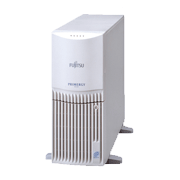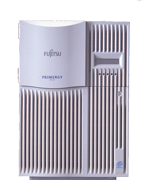Fujitsu in May 2000 rebranded all its servers, from mainframes to PC servers, under three global brands.*1 PC servers were now marketed under the new PRIMERGY brand, which took over from the GRANPOWER 5000 series. Fujitsu announced the first slate of seven PRIMERGY models (PRIMERGY ES200, ES210, ES280, ES310, MS380, MS410, and TS110) in May 2000. All were IA*2 servers intended for the Internet age.
Features of the initial PRIMERGY models:
- (1)Flexible system expansion with easy Internet server expansion
- Fujitsu offered the TS110 rack-mount server, which required only one rack unit (about 4.4 centimeters). This space-saving server provided easy scalability for WWW server or proxy server applications.
- (2)Latest technology for faster total system throughput
- The servers were equipped with Intel Pentium III processors (866 MHz), a fast 133 MHz front side bus (FSB), a dual-memory-bus architecture, and an Ultra 160 SCSI*3 interface with a 160 MB/s transfer speed.
- (3)Latest fault-tolerant infrastructure to back growing Net businesses
-
- Higher availability
Hard disk bays, redundant power-supply functions, hot-pluggable redundant cooling fans, hot-pluggable PCI slots, etc.
- Management panel
Integrated management panel (IMP) equipped with a proprietary hardware-management processor.
- Fast troubleshooting
Fujitsu’s fast reliable diagnosis 2 (FRD2) function detected faults in more units and components than the previous function. The servers’ front-panel LCD displayed about 200 types of error messages for faster error analysis and identification of faulty components.
- Preventative maintenance
The preventative maintenance alerting 2 (PMA2) function predicted faults and managed components requiring regular replacement.
- Automatic restart
The auto server restart 2 (ASR2) function automatically restarted the server if it crashed while operating or during a system boot.
- Higher availability
- *1.Fujitsu segmented its server brands as follows: PRIMERGY: PC servers; PRIMERGY 6000: office computers; PRIMEPOWER: UNIX servers.
*2. IA: Intel architecture.
*3.SCSI: Small computer system interface. A set of standards for physically connecting and transferring data between computers and peripheral devices, such as magnetic disks.
| Model name | ES200 | ES210 | ES280 | ES310 | MS380 | MS410 | TS110 |
|---|---|---|---|---|---|---|---|
| Introduced | May 2000 | ||||||
| Type | Entry server | Mid-range server | Rack mount | ||||
| CPU | PentiumIII | ||||||
| 600MHz | 600MHz/ 700MHz/ 850MHz |
600MHz/ 700MHz/ 750MHz/ 800MHz |
733MHz/ 800MHz/ 866MHz |
600MHz/ 700MHz/ 800MHz/ 850MHz |
733MHz/ 800MHz/ 866MHz |
650MHz | |
| or Celeron 500MHz |
--- | ||||||
| Max. number of ways(*1) | 1 | 2 | 1 | ||||
| Max. main memory capacity | 768MB | 1GB | 4GB | 2GB | 4GB | 1GB | |
| Disk capacity | 77.2GB | 72.8GB | 91GB | 145.6GB | 291.2GB | 13.6GB | |
| OS | Microsoft Windows2000 Server,Linux | ||||||
| Other details |
|
||||||
(*1)The number of ways is equivalent to the number of CPUs.
The specifications above were correct at the time the products were announced. Some specifications were later revised due to product upgrades.
After the Fujitsu PRIMERGY series was introduced in May 2000, many additional specification enhancements and model variations were released.




